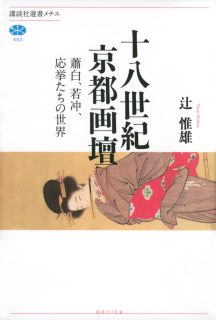Nobuo TSUJI, Revolutionary Artists in Eighteenth-Century Kyoto:
Shohaku, Jakuchu, Okyo and Others
辻惟雄『十八世紀京都画壇:蕭白、若冲、応挙たちの世界』
東京:講談社、2019年

https://bookclub.kodansha.co.jp/product?item=0000319179
Tsuji Nobuo (1932-) is an eminent art historian of early modern Japan having contributed to the postwar rediscovery of Ito Jakuchu (1716-1800), Soga Shohaku (1730-81) and Nagasawa Rosetsu (1754-99). Before the publication of his Genealogy of the Fantastic Imagination (1970), these artists had been almost forgotten. Tsuji’s intellectual exploration has highlighted various strands of Edo visual culture beyond the rise of Ukiyo-e. Revolutionary Artists in Eighteenth-Century Kyoto: Shohaku, Jakuchu, Okyo and Others (2019) is a collection of his essays exploring the ways in which cultural upheaval mediates new ideas and forms of artistic expression. The book closely examines Maruyama Okyo (1733-95) and his pupils, Ike no Taiga (1723-76) and Yosa Buson (1716-83) in addition to several fantastic artists, including Jakuchu and Shohaku, whom Tsuji had discussed in a previous monograph. These revolutionary painters were neighbors in eighteenth-century Kyoto, and many of them knew each other personally. Their experiments in visual representation underlay the diversity of early modern Japanese art, and did not converge into any single school. Tsuji aims to discuss the process and context of this cultural flourishing under which revolutionary artists produced eccentric works vividly expressing their individual characters.
The first chapter presents the colorful panorama of eighteenth-century Kyoto and the lively figures of the remarkable artists who lived there. The rise of proto-commercial society nurtured the independent spirit of merchants and craftsmen, who appreciated the fantastic imagination. These citizens enjoyed the eighteenth-century art world as an imaginative space free from the hierarchical order of society under the Tokugawa shogunate (11). They felt that curious subjects in the “floating world” could heal their sorrows and ease the boredom of their daily lives in the “floating world” (11). Eighteenth-century Japanese were fascinated by foreign objects and new technologies. Even though the Tokugawa shogunate prohibited international exchange except the foreign trade in Nagasaki, the public at the time had indirect encounters with European culture through the limited circulation of imported copperplate prints and other foreign goods. Maruyama Okyo, being inspired by Western stereoscopes, applied perspective drawing from Western art to his pictorial experiments known as the production of “megane-e” (28). Tsuji suggests that this kind of fragmentary knowledge and limited experience of the West stimulated the imagination of Japanese painters even though their understanding of foreign culture was sometimes inaccurate (12-13). These misinterpretations, however, catalyzed creative experiments in the visual culture of eighteenth-century Kyoto.
In addition to interaction with Europe, early modern Japan also experienced an influx of ideas works from China including Chinese literati painting. This influence is a main theme for the second chapter. Due to the decline of the Ming dynasty in seventeenth-century China, a certain number of Chinese intellectuals chose to move to Japan, rejecting their service to the succeeding Qing dynasty. Buddhist priests, who comprised some of these intellectuals in exile, introduced current Chinese art and related cultural trends to early modern Japan. Their founding of the Manpuku Temple in Kyoto in 1661 was highly influential in spreading new ideas and techniques concerning Chinese painting among local citizens (13-14). Japanese artists in eighteenth-century Kyoto were engaged in this ongoing process of absorbing the cultural impact from China into their own tradition of visual culture.
Following the two introductory chapters, Tsuji turns his focus to individual artists. He emphasizes that artists in eighteenth-century Kyoto closely observed and depicted the natural world. Okyo assiduously sketched animals, plants, natural landscapes and astronomical objects such as the moon (28). His sketchbook, Shasei Zatsuroku (c.1771), informed the idea and practice of realistic representation (28). Ike no Taiga was an avid traveler who produced landscape paintings during his journeys (22). He also enjoyed visiting Mt. Fuji and other mountains associated with holy places. These travel experiences were elaborated through the vivid colors in his visual narrative of Japanese landscapes (24). Yosa Buson observed the natural world through his Haiku poems, and his paintings worked in collaboration with his literary sensitivity and expressions (26). Ito Jakuchu’s work shows that close observation and empirical depiction supplemented a fantastic imagination. He regularly visited temples in Kyoto to copy the masterpieces of Chinese bird-and-flower paintings (38). He also kept hens and roosters in his house garden for observation and sketching (38). Based on these empirical practices, his singular imagination exploded, producing an extraordinary body of fantastic work. This unique conjunction between fantasy and reality is key for understanding the art world of eighteenth-century Kyoto as a whole, while also appreciating its remarkable diversity.
For Tsuji, the revolution in early modern Japanese art demonstrates that curious artists synthesized these new ideas and techniques of visual representation into their own forms of art. The eccentric expressions of the individual artists are in fact tied to their careful observations and sketches of the everyday world. Individuals as the source of experience became an important element in eighteenth-century Japanese art. This link between empiricism and individualism highlights the shared features among Jakuchu, Okyo and other eighteenth-century painters in Kyoto, even though they cannot be classified into any single school. The unity and diversity of these artists will continue to be a significant topic for those who explore the cultural landscape of eighteenth-century Kyoto. Whereas Tsuji focuses on each artist as a singular individual, his narrative also refers to the communication between these figures. Even Soga Shohaku, known as an unsociable man, enjoyed lively discussion on visual theory with Taiga (35-36). Jakuchu learnt the idea of empirical expression from a Buddhist priest, Daiten of Shokoku Temple (38). The further interpretation of this social network of artists will develop the narrative of eighteenth-century Kyoto beyond the emphasis on their eccentricity.
Yusuke Wakazawa (EAA Fellow)








